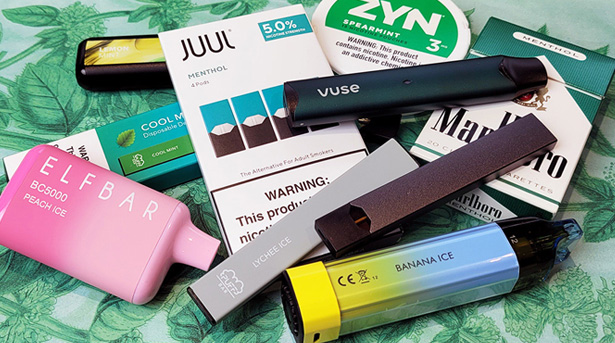
Vaping
It seemed to make sense: restrict flavored vaping products in order to lower the number of
young people smoking. Thing is, it doesn’t work. Thing is also, it does just the opposite of
what it is intended to do.
The results of a recently released study show a "high rate
of substitution" between vapes and cigarettes, meaning the
restrictive – some say unconstitutional -- policies designed to
prevent underage use are actually doing exactly the opposite of
what they were intended to do.
Laws restricting flavored nicotine vaping products have
been shown to be associated with higher, not lower, cigarette
purchases. So says the new paper, which looked at retail sales
across 44 states.
Those results lead to the same conclusion that others have
reached over the last several years: for every less than .7-milliliter
nicotine pod sold in jurisdictions with these restrictive policies,
people purchased 15 more cigarettes. Say the study’s authors,
"That tradeoff equates to over a pack more cigarettes per pod for
the size of current leading products" like Vuse Alto, which uses
1.8-milliliter pods.
The Folly
“The substitution effect identified by this study underlines the
folly of trying to protect public health by deterring the use of
electronic nicotine delivery systems (ENDS), which are far less
hazardous than combustible cigarettes,” commented reason.com.
"We find that ENDS flavor policies reduce flavored ENDS sales
as intended, but also increase cigarette sales across age groups,"
said Yale public health researcher Abigail Friedman and her
colleagues. "As cigarettes are much more lethal than ENDS, the
high rate of substitution estimated here suggests that, on net,
any population health benefits of ENDS flavor policies are likely
small or even negative."
The study looked at 15 state and 279 local flavor restrictions that
were put in place between January 7, 2018 and March 26, 2023.
Included were full-on bans on ENDS flavors besides tobacco
and laws that curbed sales of these items to specialty stores like
vape shops and tobacconists. The information was drawn from
IRI (Information Resources Incorporated), which analyzed
checkout figures from retailers including convenience stores,
supermarkets, drug stores, discount stores, and gas stations.

"ENDS sales fall and cigarette sales rise as a greater percentage
of state residents are subject to policies restricting flavored
ENDS sales," the report’s authors noted. "Effects are in the
same direction for policies prohibiting all ENDS sales (i.e.,
flavored and unflavored), consistent with substitution." Aside
from Friedman, the authors were Alex C. Liber, Georgetown
University - Cancer Prevention and Control Program; Alyssa
Crippen, Yale School of Public Health; and Michael Pesko,
University of Missouri - Department of Economics.
The effects, they added, turned out to be "larger in the long
run; that is, for policies in effect a year or longer. Separating
ENDS flavor prohibitions from less restrictive policies limiting
flavored ENDS sales to particular types of retailers reveals that
both policies yield reductions in ENDS sales and increases in
cigarette sales once in effect for at least a year."
Five Key Findings
The report itself identifies five key findings. The first is that
ENDS sales fall and cigarette sales rise as a greater percentage of
state residents are subject to policies restricting flavored ENDS
sales. “Effects are in the same direction for policies prohibiting
all ENDS sales (i.e., flavored and unflavored), consistent with
substitution.”
Second, ENDS flavor policies’ relationships to ENDS and
cigarette sales are larger over the long-run; that is, for policies
in effect a year or longer. “Indeed, when allowing differential
effects over time, the relationship between ENDS flavor
policies and cigarette sales is positive and significant in the
long-run but not the short-run.”
Third, 71% of the increase in cigarette sales associated with
ENDS flavor restrictions comes from tobacco-flavored
cigarettes. “Alongside the inclusion of controls for restrictions
on menthol cigarette sales, this finding indicates that the
observed substitution response to ENDS flavor policies cannot
be attributed to menthol cigarettes’ availability, nor fully
counteracted by menthol cigarette sales prohibitions.”
Fourth, ENDS flavor restrictions’ relationship to cigarette sales
holds across cigarette product age profiles, including for brands
disproportionately used by underage youth.
Lastly, separating ENDS flavor prohibitions from less restrictive
policies limiting flavored ENDS sales to particular types of
retailers reveals that both policies yield reductions in ENDS
sales and increases in cigarette sales once in effect for at least a
year. “These findings are consistent with flavored ENDS policies
encouraging substitution from ENDS towards combustible
cigarettes, aligning with results from 16 of 18 other studies
assessing cigarette use following adoptions of minimum
legal sales age laws for ENDS, ENDS tax rate increases, and
advertising restrictions.
In other words, the report concluded, “policies making ENDS
more expensive, less accessible, or less appealing appear to
incentivize substitution towards cigarettes.”
The only question that remains is this: are politicians and
activists who claim they want to help young people really
listening?
